35 today: The story of Arcadia’s So Red The Rose – In their own words
The story of the album featuring new interviews with Nick Rhodes, Carlos Alomar, Andy MacKay and Mark Egan
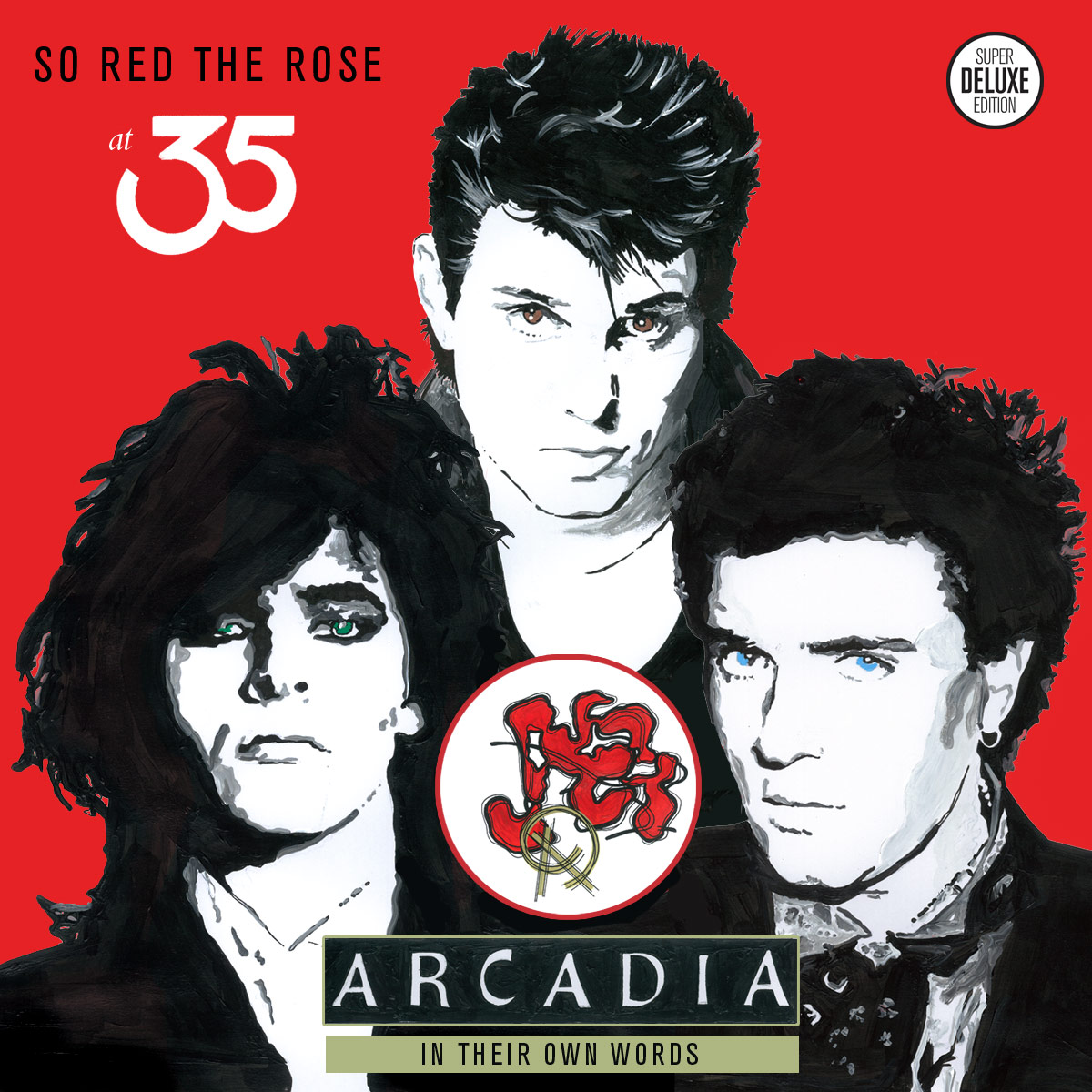
Released in November 1985, Arcadia’s only album So Red The Rose is one of the most remarkable side-projects in pop. Created by Duran Duran‘s Nick Rhodes and Simon Le Bon when they had time on their hands while Andy Taylor and John Taylor were living out their rock star dreams in The Power Station, So Red The Rose is often remembered as “the most pretentious album of all time”. But that’s largely because Simon Le Bon and Nick Rhodes keep telling people it is.
In reality, Arcadia was ahead of its time – one of the first pop or rock projects to have guest artists at its core, much like Gorillaz 25 years later. Alongside Le Bon and Rhodes – and mostly Roger Taylor, the only member to feature in both Duran spin-offs – were Japanese guitarist Masami Tsuchiya, jazz bassist Mark Egan and leftfield percussionist David Van Tieghem. Then there was a stellar roll call of Eighties talent to rival Band Aid: Grace Jones, David Gilmour, Carlos Alomar, Sting, Andy Mackay and Herbie Hancock.
John Earls speaks to Nick Rhodes and key players Mark Egan, Carlos Alomar and Andy Mackay about one of the most fascinating (and expensive) albums of the decade:
Nick Rhodes: The initial inspiration for Arcadia was the split of Duran Duran. The atom had split when John and Andy were pulling more towards modern rock with The Power Station. That wasn’t something I was interested in, nor was I invited to it anyway. I wanted to make a really beautiful record, something more textured and esoteric.
Newly married to department store heiress Julie Anne Friedman, there was no temptation for Rhodes to enjoy the enforced break.
Nick Rhodes: I don’t see the point in breaks. We’re only here once, so far as we know, and I don’t think a lot happens in a break. It’s nice for a couple of weeks to relax and gather your thoughts, but after that I get very, very bored. When I go on holiday, I have to be somewhere where there’s things to do and see. The idea of somewhere like the Maldives, as beautiful as I’m sure it is, slightly horrifies me. A day trip there would be fine for me.
Simon Le Bon (Interviewed on Canadian music TV show Good Rocking Tonite, 1985): Arcadia is really the fault of the gas meter man. I was already packed, suitcases by my side, ready to go on holiday. I had the plane booked, to go to the sunny Caribbean islands for Christmas. There was a knock on the door – the gas man. After he’d rummaged away and was finally leaving, the phone rang and it was Nick, saying “Don’t go on holiday. Stay here and let’s make a record.”
Nick Rhodes: It’s true that Simon thought he was going on holiday for six months, until I told him “No, no, no.” But I knew Simon would agree to stay. Simon will take any opportunity for sun, sea and piracy, but he really loves to work. He’s a proper artist, who takes things seriously. Simon loves to write music and to do something that other people haven’t done. Simon is excited by things that are unique. It’s why we’ve managed to maintain our creative relationship and why I don’t think it’s suffered over the years.
The Power Station’s success was a motivator for Rhodes and Le Bon. Released in March 1985, their self-titled debut album reached number six in the US and number 12 in the UK, with ‘Some Like It Hot’ and ‘Get It On’ both Top 10 singles in the States.
Nick Rhodes: There was a little unspoken competition between the two bands, but I thought The Power Station did a really good job. I remain a big Robert Palmer fan, as he was an extraordinarily talented singer and writer. John and I had seen him as teenagers at Birmingham Odeon and what Robert did was unlike anyone else at the time. We didn’t think any of the competition was serious, and we were still in touch. Andy had drifted into a different direction, but John and I still spoke all the time. I was 10 and John 12 when we met, so we weren’t going to stop talking. When Russell Mulcahy directed the video for ‘The Flame’, John appeared in it, so he joined our camp. But of course, we wanted to do better than The Power Station and they wanted to do better than us.
Roger Taylor was the only member to play on both The Power Station and Arcadia’s albums, though session drummer Steve Jordan also joined the Arcadia sessions.
Roger Taylor (interviewed in Bass Gear, 2016): I was caught in the middle of two ships sailing in different directions, trying to keep one foot on each vessel. There was no pressure to be involved in either project, but I naturally gravitated towards Arcadia, purely because The Power Station had become a US-based project and already had the mighty Tony Thompson from Chic on board.
Nick Rhodes: We got Steve Jordan in once it became clear that Roger wasn’t going to do the whole record.
Mark Egan: I’d played with Steve since 1976, when we were in The 24th. Street Band. Steve is a great drummer – very creative with great grooves – and he was my first recommendation when Alex Sadkin asked if I could recommend a good drummer. Steve and I had a great rapport and I love his attitude too. Steve’s a real team player.
Working with other musicians was key to Arcadia’s ethos from the start.
Nick Rhodes: Arcadia was chance to open a whole new Pandora’s box for us as musicians. I was 23 and I’d never worked with other musicians, apart from the members of Duran Duran. This wasn’t the time of the ‘featured artist’, so you tended to do your own thing and stay in your own universe. Simon and I were suddenly free with, it has to be said, a fairly substantial budget. We could invite other musicians we admired to work with us, to just make whatever we wanted. Arcadia was the result.
The pair went to Paris to record at Studio Grande Armée. A state-of-the-art complex built in 1972, the studio remains one of the largest in the world.
Nick Rhodes: We ran to Paris to escape the madness of London, where our lives had become a little unmanageable. It was constant hysteria, with people ringing our doorbells every day, night and day, while press hid in the bushes. We knew we didn’t want to work in America, and Paris sounded nice and cosmopolitan. Also, it was close by, so we could easily get back to London whenever we wanted. Studio Grande Armée was fairly central, just past the Arc De Triomphe, and we had friends there. The Rolling Stones were recording Dirty Work, the Thompson Twins were in town. We led a pretty straightforward life, working in the studio for 16 hours a day. But, when we took half-a-day off, I’d walk and walk. Walking around Paris was an inspiration, as it was impressive to young guys from the middle of Britain.
Andy Mackay: I can remember recording specific tracks for Arcadia a little bit, but what I mostly remember it for is how pleasant the sessions were. Thinking of Arcadia takes me back to Paris in the sun. I’m a greedy person who likes traveling around Europe finding nice places to eat. I can’t remember exactly where it was or what we ate, but Arcadia was an excellent dinner. Nick and Simon are very civilised people who enjoy good things.
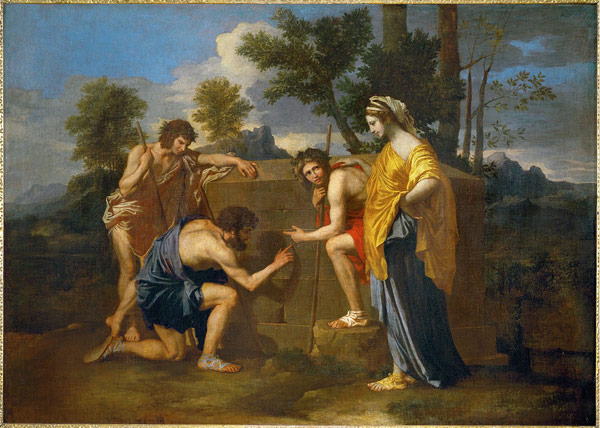
‘Et in Arcadia ego’ is the painting by Nicolas Poussin (from 1637-38) which gave the band their name
On one of his visits to the Louvre, Rhodes saw Nicolas Poussin’s painting ‘Et in Arcadia ego’ that gave the band its name.
Nick Rhodes: I can’t remember exactly which point in the process it was that I saw Poussin’s painting, wandering around the Louvre. I began looking things up and I liked that it’s tied in with the Knights Templar. I guess the Knights Templar are really like the Freemasons, but I liked that a mystical French secret society was involved. I loved that Jean Cocteau was a Knight Templar, as I was deeply into my Cocteau phase at that point, especially as I was living in Paris. We were all living at Hôtel Plaza Athénée and the bills were getting so huge that I thought “I could have bought an apartment by now.” So I bought an apartment across the street. Once I did that, I began collecting Cocteau drawings and paintings. I love the word ‘arcadia’. It looks right graphically, with the ‘A’ at the beginning and end, and it sounds pleasing.
No other names were considered. Often, there’s a list: we had ‘RAF’ before we got to Duran Duran. With Arcadia, we were looking for something that you couldn’t tie down, something from a different time period. We’d chosen Duran Duran as our name because it could only end up meaning us as a band. Even though we’d taken it from an incredible Sixties science-fiction movie in Barbarella, we felt that was it, that was our name. We didn’t want a name that suggested a specific sound. Led Zeppelin and Black Sabbath suggest something musically. The Power Station does for sure too, and that name was spot-on for them at the time, but we didn’t want that. I suppose we wanted Arcadia to suggest something in the mists of the past.
Joining Rhodes and Le Bon as co-producer was Alex Sadkin. The producer of Duran’s previous album Seven And The Ragged Tiger, Sadkin is one of the great forgotten producers of the Eighties, largely as he died young, aged just 38 when he was killed in a car crash in 1987. As well as Duran, Sadkin produced Grace Jones, The Thompson Twins, Robert Palmer and Simply Red.
Mark Egan: Alex was the ideal producer. Firstly, he’d started as a musician, so he understood how the lyrics and sonics worked. Secondly, he was a great engineer with a recording background, so if something wasn’t leaping out of the sound board, Alex could manipulate it. Thirdly, Alex was great in organising sessions to keep them on track. You always felt there was forward motion. That’s a very rare combination. Everything Alex did was thought out and considered. He took input from everyone so that no-one felt forced into doing anything, while keeping the momentum going. Larry Alexander, the engineer, was great too. Whenever Alex said “We have to get this sound,” Larry was right there. Having worked at Power Station studios in New York, Larry was very adept. Like Alex, Larry was always positive. They were always ready with input, there was no complaining, they were just always ready to go.
Andy Mackay: Alex was very good at what he did, but it was Nick and Simon driving it all. It seemed like a self-produced album. It certainly wasn’t like working with Chris Thomas on Roxy Music albums, as Chris was a terrible slavedriver. He’d make me redo takes and say “No, we can do that better.” It was much more relaxed with Arcadia.
Sadkin helped choose the players for the album, with Egan his suggestion as bassist. Egan was mainly known for jazz, previously part of The Pat Metheny Group and playing with David Sanborn.
Nick Rhodes: Mark Egan was a genius suggestion from Alex. John Taylor is a bass player unlike any other, and I wouldn’t swap him for anyone else in the universe. So it was a little odd to have to think “OK, who do we get to play bass?” Alex said: “No, it’s fine. We need this jazz player, Mark Egan. He’s different and you’ll love the way he plays.” Alex said Mark played a lot of fretless bass and was great with harmonics, both of which I loved at the time and still do. When Mark came, he was from another planet.
Mark Egan: Alex was producing ‘I Want To Know What Love Is’ for Foreigner at the time. I was on a session at the same studio, Right Track in New York, when I bumped into Alex in the lobby. Alex said “Come on in,” so I met the Foreigner guys and heard a little of them record that classic song. Then Alex said: “Hey, would you be interested in playing on this record with two of the members of Duran Duran?” and I immediately said “Absolutely!” Alex was an old friend from way back. We’d seen each other over the years, and when Alex bumped into me in Right Track he’d sensed that Nick and Simon wanted to do a very different and creative project. I think I just clicked for Alex, as I came from a different angle than maybe a rock player would.
Completing the main core of the session players, Masami Tsuchiya had played with Japan and Ryuichi Sakamoto, while David Van Tieghem had worked with Brian Eno and Laurie Anderson.
Nick Rhodes: Masami was a unique player, whose guitar was a key part of Arcadia. He was so generous with his time, a lovely man. David was so versatile and experimental, a hugely inspiring character, as were Mark and Masami. David had done a lot of experimental percussion pieces and was just wonderful. The cross-section of international musicians who play on So Red The Rose give it an exotic veneer that I don’t really hear on records that often. It’s certainly unique and there’s no other record from that time period which attempted to move in those directions. For that alone, I’m happy that Arcadia exists.
Famously, So Red The Rose eventually cost £1m to record. It’s an album free from time constraints, with The Power Station starting and finishing their tour by the time Arcadia released their album.
Nick Rhodes: Arcadia is the longest we’ve ever consistently spent on one album. Some Duran Duran albums have taken longer, but that’s because we’ll do a week here and a week there. We were pretty much in there for 18 months making Arcadia, because we didn’t know where we were going. We’d paint a canvas one day, then I’d go in the next morning and paint over it again. Then, after painting over it, I’d sometimes think “I wish I hadn’t done that. Let’s go back and listen to that again.” We felt that we were trying to pioneer a new ambient, esoteric art framework. Each drumbeat, each snare sound, every breath in between became a huge focus, to the point of obsession. I can look at it now and say I’m glad that I did it, but I’m also glad that I learned you can’t do it like that all the time.
Just how were Arcadia able to afford such marathon sessions?
Nick Rhodes: We’d made so much money for EMI at that that point, they couldn’t really dictate to us in any way. The one thing we had in Duran Duran’s contract that was in our favour was artistic control over everything. I don’t know how I pulled that off at 17, but I insisted on it and we got it. I wish I’d known a little more about the financial side of the music business, as we definitely didn’t receive that bit, but at least we were able to make whatever we wanted. We had the final say over everything and, yes, Arcadia did cost a lot of money. We didn’t really make much profit – if any – to this day. But I’m not really driven by that.
It’s great to make money and be able to do the nice things in life, but it’s always been about getting to the next project and doing what we want with it. The money we made on Duran Duran’s albums went back into the next one, and if that meant we went over budget on one, we could afford it from the profits of the previous records. Arcadia wasn’t paid for by the record label, it was paid for by Simon and I.
Andy Mackay: Back then, if you were in a successful band, you were able to have a pretty good budget to record and studios were very luxurious. It’s unheard of now to spend the amount of time you did in studios then. There are very few studios left, so it simply doesn’t happen that you’d block book an expensive studio for weeks and only work when you feel like it. Now, you have to already know what you’re doing by the time you get in a studio, but of course you’ll have been able to do most of it on your laptop. It’s not as much fun, I have to say. I can imagine that Arcadia’s album was expensive, as Duran had made so much money that Simon and Nick could enjoy doing that one. Those were the days when you could say “Oh, I think we need a bagpipe here” and fly over a bagpipe player to wherever you were in the world.
Before starting work on the songwriting in earnest, only one song already existed in a nascent form. ‘Missing’ was plundered from the same notebook of Simon Le Bon’s which had offered ‘The Chauffeur’ on Rio.
Nick Rhodes: ‘Missing’ was picked out of Simon’s book, a lyric of his that I particularly liked. It’s a ghost story. I liked to plunder that book of Simon’s, as he went through a period where he really tapped into something. Lyrically, ‘Missing’ is a little surreal and beautifully abstract, yet it’s also relatable. I like that. I’m not a big fan of traditional love songs, lyrically. I prefer things that are a bit vaguer, that leave a little to the imagination. Simon, when he does that well, is as good as anyone. But that was the only song that was written in advance.
Carlos Alomar: When Nick and Simon explained that Duran Duran had segmented into two bands, I had a little trepidation. I’d heard The Power Station and said “Do you want to follow along their lines?” I was friends with Tony Thompson, so I knew what The Power Station were getting themselves into, in New York on Duran’s other side, and I figured if they did want to go down that route, I could offer “How heavy do you want me to be?” They didn’t want that, and they didn’t quite know what they wanted. What they didn’t want was to sound like Duran Duran. I said: “That’s crazy, how could you not want to be Duran Duran when you are Duran Duran?”
The keyboards Nick was laying down were gigantic, with stabbing string sounds coming from his keyboards. That sound was pretty much there already in the demos I heard. What they did want was “Something funky.” So I accented what I heard with all the playing they needed to make it funky. Because those songs were good, but they weren’t funky.
Wanting Arcadia to be a collaborative collective, there were natural nerves as to whether the guest musicians would come through.
Nick Rhodes: We didn’t really know if anyone would actually turn up. We had the core of our initial band in Masami, Mark and David, and we also had Roger, who was between our camp and The Power Station’s, though obviously they also had Tony Thompson, so Roger’s role was limited on their record. But that was it. Then other people started drifting in and out.
Carlos Alomar: When I arrived at Arcadia’s studio, it was like when I met Alicia Keys – Nick and Simon were just as reverent. Nick was so glad I was there, going “The fact you would even consider this…” I was like “Dude! Lighten up man, it’s all good.” He called me “Mr Alomar” at first, which was so respectful, but had to be corrected straight away – “Please, it’s Carlos.” That was very sweet, and they were so kind, so accepting.
Andy Mackay: It’s funny, asking established artists to play with other people. You think it might be quite hard to get them but, if someone asks you, you nearly always say yes. If you’ve got a particular player in mind for a song, you might as well ask them, because they’ll quite likely agree to it. I always enjoyed doing sessions with new bands as well as established artists. I expected people to pay me if they’re earning a lot of money, but if they didn’t, I wouldn’t ask and I didn’t mind. Arcadia would have definitely paid a fee, but I can’t remember what it was. I imagine they would have paid the nice expenses too.
The collaborative nature of So Red The Rose extended to letting the guest musicians be as free as possible in playing what they wanted.
Nick Rhodes: You don’t get great musicians to play on your record and just say to them “Can you play that, please?” That’s limiting their palette and tying one hand behind their back. The great joy of working with these incredible musicians is to see what they do creatively, where they go, to see what sounds and notes they pick.
Carlos Alomar: Some of the music was rather romantic. I’m a chordmeister and the Major 7th makes for very romantic sounds. When they gave me ‘Election Day’ to play on, man, there were a lot of holes – there wasn’t a lot of music in there. But that was great, because I thought “What a wonderful playground to just muck about in!” I tried things out around the Major 7th, wanting to figure out what made Nick and Simon work on an emotional level. I approached it the way I did recording Fame for David – treat the song like four or five guitar players battling for the centre spot. There’d be five snappy guitar styles they could later decide which ones they wanted to leave in and which ones to leave out, or maybe they might want to cut-and-paste from a few things. My main notion was in giving them options. I’m glad they didn’t want heavy, Iggy-and-David type playing, because it would have been unnecessarily harsh for Arcadia’s music. I didn’t do anything harsh on rhythm guitar either. You’ll notice Arcadia doesn’t have a lot of rhythm stuff.
Mark Egan: The demos left me very open to add to the mix. They were basically keyboard-driven loops with some vocals: it was the essence of the songs. ‘Lady Ice’ and ‘Missing’ were especially open and impressionistic, songs where we did a lot of experimenting in the studio with multi-tracks and extended jams before picking out some of those parts and working on them further.
Andy Mackay: I usually do a take from start to finish, playing whatever comes into my head, generally on alto sax first to see how that goes. Then I’ll do a tenor take to see if that fits better and possibly soprano too. Really, I’m happiest playing alto, but on Arcadia I play more tenor than usual – rock & roll sax always sounds better on tenor.
Despite Duran Duran’s megastar status, the players on So Red The Rose recall the sessions as relaxed.
Andy Mackay: Simon and Nick were both very pleasant to work with. Simon knew what he wanted and Nick is very creative. A lot of people used to dismiss Duran Duran and say that Nick wasn’t a technically great keyboard player, but in fact they’re the people who come up with the best ideas: good tunes, good riffs. It was very relaxed in Paris, very pleasant.
Mark Egan: I didn’t feel there was any pressure to make a platinum record. It was just an experimental time, as they’d already had the hits. Duran Duran were a mega, mega band in 1985, just huge, but they wanted to do something a little different. It was the space to make a creative record without that Duran name. The pressure would maybe have been there if it was a Duran Duran record.
Meanwhile, guests continued to arrive in Paris. Grace Jones recorded the spoken middle section for ‘Election Day’.
Nick Rhodes: Grace Jones is so important to Arcadia’s album. She’s one of the most underrated performers of her time. Artistically, Grace was phenomenal. Warm Leatherette and Nightclubbing are albums I play more than almost anything else I own. Stylistically, with the help of Jean Paul Goude, Grace paved the way for so many singers. Grace was about a week late getting to the studio, though I soon became aware that in Grace’s world that wasn’t too bad.
Simon Le Bon (Writing on Duranduran.com in 2015): I wrote that middle section from scratch the day Grace came down. She isn’t a lyricist, so I wrote it for her very fast, in that slightly vague style I used to write in. Grace said: “Simon, what the fuck does this mean? What’s it about?”
Sting simply came in to do backing vocals on ‘The Promise’, while Herbie Hancock was also recording at Studio Grande Armée.
Nick Rhodes: Sting just happened to be in Paris and we’d known each other for a while. When we were at Band Aid, I heard Sting and Simon sing together and thought “Oh, there’s something here.” I knew they’d work well and it was great hearing them sing together again. Herbie Hancock was in the studio next door, so getting him was easy. Although Herbie only has a very small cameo, it was wonderful as a keyboard player for me to watch someone of his calibre. Seeing how his hands move over the keyboard and hearing what he played over what we’d already made was just a joy, an experience like I’d never had.
Pink Floyd’s David Gilmour was also there, but not all the superstars to visit Studio Grande Armée are on the album.
Nick Rhodes: David Gilmour was a revelation, because I hadn’t grown up as a massive Pink Floyd fan. I was more turned on by glam rock and electronic music but, by my early twenties, I’d discovered Pink Floyd properly. David’s subtlety and choice of melodic notes were compelling. Of course, we had no notion of whether or not he’d be even slightly interested in coming to play on our record. But, once he accepted, he stayed with us for about a week. It was uplifting and exciting to see what David could do. ‘The Promise’ is the song he really shines on for me; the intro is as pure David Gilmour as you can get.
Mark Egan: Paris is such a melting pot and people would come over just to check on what we were doing. Mick Jagger and Charlie Watts came by. I played a jazz groove with Charlie in one of the drum rooms, me on an acoustic bass I’d played on ‘Missing’.
Nick Rhodes: I didn’t ask Mick to be on the album. I have huge admiration for him as an artist, but I didn’t see it particularly for that record. If we’d been making a different sounding record, then of course I’d have asked. We were spending a lot of time together at that point. I hadn’t known the Stones that much before that period, but they were making a record in Paris too, so we’d go to each other’s studios and go out to dinner a lot. We had fun, chasing around Paris together.
With the guests arriving and the core band finding their way, the songs eventually began to fall into place.
Nick Rhodes: ‘Missing’ is pretty much live and its sound probably inspired everything else on the album. Structurally, it’s quite simple, but we wanted to somehow make it sound mystical, magical and unpredictable. At Alex’s suggestion, David, Mark and Masami played live in the studio room, with Simon in the vocal booth: we’d decided we didn’t want a traditional drum track. I was getting my synth sound ready in the control room, readying it to play live, so I couldn’t hear what everyone else was doing. When I was ready, I asked Alex to check everyone else was ready. He pushed the faders up… and I’d never heard a sound like it in my life. It was so beautifully alien. I was virtually speechless, which doesn’t happen often. It was almost unbelievable, how they’d found this sound within the notes and chord structures we’d set forward as ‘Missing’’s track. It was extraordinary and I now knew there was a way to make the painting different.
Carlos Alomar: Nick was very helpful in suggesting “Yeah, that’s cool” or “Do that other thing you did”. Arcadia’s sound was rather pristine and Nick would say “Be two thoroughly different guitar players, one for the left side of the speakers and one for the right.” Those differences become ear candy when you put on headphones. If you play the same thing for both speakers, it just becomes massive stereo. Doing it so differently made for better ear candy, almost like I was playing call-and-response. It also allowed Nick to have more space in the middle of the sound to add his gigantic keyboards.
Mark Egan: I don’t believe there were any pre-existing basslines. As Roger and Steve started to play with those grooves, it dictated the basslines I was going to play. We’d come up with a bassline inspired by the drums and whatever Simon was singing.
Carlos Alomar: Simon helped a lot on ‘Goodbye Is Forever’. He and Nick had a thing about sustaining sounds to make it dance-y. I did more rhythm playing on Goodbye Is Forever, but it was too much. Simon pointed that out, going “No, no, just play it a little tighter.” On most of the songs, there’s a lot of space in the finished version.
Although Roger Taylor plays the final versions of most songs, ‘Lady Ice’ excepted, he and Steve Jordan swapped around on the drum stool during the album sessions.
Roger Taylor (speaking in Bass Gear): Arcadia was all about being free and shedding the chains of the previous few years. Steve did an amazing job on ‘Lady Ice’, playing something so extraordinary that I could never have imagined playing myself.
Mark Egan: We traded off on different things between Roger and Steve, but in the end Roger played on most of the songs. Roger came from more of a rock/pop/funk playing and is so solid. We hooked up immediately with the groove, I felt a kinship with him straight away. He was a great partner to play with.
Because each guest musician played so many different alternative suggestions, there is a lot of unreleased music in the vaults.
Mark Egan: There have to be a lot of outtakes. I’d get a cassette every day of that day’s work and I still have all of those. There’s a lot of music on those tapes that’s not on the finished record. But I like everything that came out on the record. I don’t feel any regrets of “Oh gee, they should have released that version of the song instead.”
Nick Rhodes: There are a lot of alternate versions of songs. ‘Election Day’ had 30 different guitar parts on it in the end, for example. Every guitarist we had played on it: Carlos, Masami, David. That perhaps starts to explain why the record took so long, as we piled up different parts on so many things. We had an unbelievable amount of options, which means the editing process can take forever. I could probably make half-a-dozen different versions of the whole album with the different parts people played, so mixing the album was quite complicated.
Carlos Alomar: When I heard some of the remixes of ‘Election Day’, I thought “Oh, OK. That’s cool, so that’s where that version of my playing went.”
Nick Rhodes: The mix of ‘Election Day’ is the single longest mix I’ve ever been involved in. I worked on it with Francois Kervorkian, who was a proper artist. He’d find more layers by fiddling around with shortwave radios, adding delays and reverbs to individual snare drum sounds. This was at the beginning of automation, so it wasn’t like you could save everything. Francois brought something really special, helping us to establish new boundaries. But it took time. The fact I could make ‘Election Day’ 85 percent different from one week to the next was a little unnerving, as we were trying to pull together an overall sound for the album. You start cutting up bits of paper, then there’s thousands of them on the floor.
The limitations of vinyl curtailed some of Arcadia’s vision for the album, notably on its instrumental song ‘Rose Arcana’, which only lasts 51 seconds on the record.
Nick Rhodes: My initial feeling during the mixing period was that the songs should all be longer. I thought it should feel more conceptual, rather than little blasts of pop tracks. At some point, every song was probably eight or nine minutes. I wanted the album to be an experience, but this was at a time when albums were still very much led by vinyl. The only thing that made me sad is that we had quite long versions which we wanted to include but couldn’t. It wasn’t going to be a double album, so a few tracks got truncated. I really wanted to put the full-length version of ‘Rose Arcana’ on there, but we couldn’t.
‘Rose Arcana’ and Election Day’s B-side ‘She’s Moody And Grey, She’s Mean And She’s Restless’ weren’t the only instrumentals recorded during the sessions.
Nick Rhodes: Simon loves instrumentals, not least because it means he doesn’t have to come up with lyrics. ‘Rose Arcana’ was always intended to be instrumental and there was another instrumental recorded for the album, which is the only song which didn’t get released at the time. The working title on the tape box was ‘The Queen Mother’, a joke title like all bands have that we’d never actually use for anything. That song only didn’t make it because of space, not because we didn’t like it.
A month before the album, ‘Election Day’ was released as the lead single from ‘So Red The Rose’ in October 1985. It reached number seven in the UK and charted one place higher in the US, matching The Power Station’s American peak for ‘Some Like It Hot’ eight months earlier. For the follow-up single, ‘The Promise’ reached number 37 in Britain, while the rest of the world chose ‘Goodbye Is Forever’, which charted at number 33 in the States. ‘The Flame’ stalled at number 58 in the UK in July 1986, three months before Duran returned with the title track of ‘Notorious’. So Red The Rose itself peaked at number 23 in the States and number 30 in the UK.
Nick Rhodes: ‘Election Day’ wasn’t as successful as Duran Duran singles had been, but nor did we expect that, or the other singles, to be. We didn’t expect The Power Station to be as successful either.
Mark Egan: ‘Election Day’ wasn’t multi-platinum, but it was platinum, so I was thrilled. I was on a hit record and I was an integral part of it.
Nick Rhodes: What was interesting is that both our album and The Power Station’s sold approximately the same amount of copies. They did a little better in America, which we expected as it’s a heavy record, while Arcadia did a little better in Europe and Japan.
Andy Mackay: It’s no surprise Arcadia did quite well commercially but not as well as Duran. It’s always difficult when you’re in a band that’s had so much success to do a solo album or a side-project album. By and large, you’re struggling, as the public always want another album by the main group. The exception is when you do something very different. Bryan’s solo albums did very well, which slightly surprised me, but they were very clearly different from Roxy. I’ve done solo albums I really enjoyed making, even though they haven’t been huge commercial successes.
An album so far from Duran Duran’s pop roots was always going to confound critics, with New York Times’ review especially off. Their critic Ethlie Ann Vaire wrote: “The question is, are the Duranites taking admirable musical risks – and falling forgivably on their faces – or are they committing self-indulgence to vinyl and laughing all the way to the bank?”
It’s perhaps small wonder that Arcadia themselves initially distanced themselves from the album, with both Le Bon and Rhodes soon labelling So Red The Rose “The most pretentious album ever made”. The intervening 35 years have seen it deservedly reassessed as an intoxicating, hypnotic ride. It’s not just Andy Mackay’s presence that makes So Red The Rose the best album Roxy Music never made.
Andy Mackay: People were bound to make Roxy comparisons. Obviously, the Duranies were Roxy fans and were influenced by us. It was flattering to be asked by Nick and Simon to play on their album, but I could also see where they were coming from in doing so. There was a degree of respect for Roxy that I was aware of.
Nick Rhodes: I never mind being called pretentious. Pretentious as in pretending? Great. I grew up loving fantasy and science-fiction. Literature like The Picture Of Dorian Gray, The War Of The Worlds or 1984 is infinitely more interesting to me than beautiful true stories, and that element has remained within all the work I get involved in. The world we live in is difficult enough as it is. People who do something different, though it might not solve the country’s crises, may well give a little respite and pleasure outside of the agonies on the other side of the fence. They should be celebrated.
While The Power Station celebrated their album with an infamously drug-fuelled tour, Arcadia never played any full concerts.
Nick Rhodes: Playing shows would have been complicated. Had we asked everybody at the time, maybe we could have ended up with ended up with a star-spangled band. But no, we never looked into it. Perhaps we could have got the key band of Masami, Mark and David, with Steve on drums, but then we’d have needed a great sax player for some parts. You never know, maybe Andy would have done it.
Andy Mackay: I love playing live and, when people ask, I’m happy to do it. I don’t want to slob around gigging forever, but it’s always nice to play. If the timing had been possible, I’d have done it.
A two-CD edition of ‘So Red The Rose’ was released for its 25th anniversary in 2010. With so many other alternative versions and unreleased takes, a fuller version could potentially happen.
Nick Rhodes: I should probably look at it all one day. I don’t want some rogue from the record company going in and looking at everything. As a fan, I always love to hear the outtakes, so long as it appears the artist has wanted you to hear them. If I had the time and inclination to go into those tapes then, yes, there are some really interesting alternate versions and maybe a few jams that didn’t get turned into proper songs. I wouldn’t be averse to it.
As the album turns 35, how do the key players think it’s held up?
Carlos Alomar: I’m pleased I helped Nick and Simon create a nice space where they managed something that wasn’t Duran Duran and didn’t disturb their Duran Duran brand. Arcadia, and The Power Station, were a placeholder so Duran Duran could get back together. I didn’t go into the session with this intention, but I didn’t want Arcadia to be such a success that they might not consider going back to Duran. And the fact Duran Duran did get back together again, I thought “Yeah!”
Andy Mackay: I think it’s a great album. I liked it and I liked the experience, but I must admit I haven’t heard it for ages.
Mark Egan: I love the record. My wife is a very big fan of Arcadia, so we play it from time to time and it’s sometimes on heavy rotation in my car. I have the album in a lot of different formats and I’ve purchased extra copies so I can send CDs to friends.
Nick Rhodes: I felt happy about it when I last heard it three or four years ago. When things become antiques, which at this point Arcadia is, they either have an ageless shimmer or they decay badly. I’m proud to say that most of the records we’ve released were crafted so carefully that they’ve held up. It’s about getting things right. Arcadia took a long time, it was undoubtedly an expensive record to make, but I had a lot of fun making it and I think it marks a time period of a beautiful convergence between analogue and emerging digital technology. Learning the way different artists work was inspirational and put us on a different trajectory when we returned to Duran Duran. Arcadia has very little to do with the sound of Notorious, but it cleaned the slate and let me think “OK, now we can move on to something entirely different.”
Finally, could a long-overdue second Arcadia album happen?
Nick Rhodes: Simon and I have only talked about it in jest. The only time it’s ever arisen is when one of us says: “If we save up all the money we earn for the next 10 years, we could make another Arcadia record.”
Thanks to Nick Rhodes, Carlos Alomar, Andy MacKay and Mark Egan who were interviewed for SDE by John Earls.
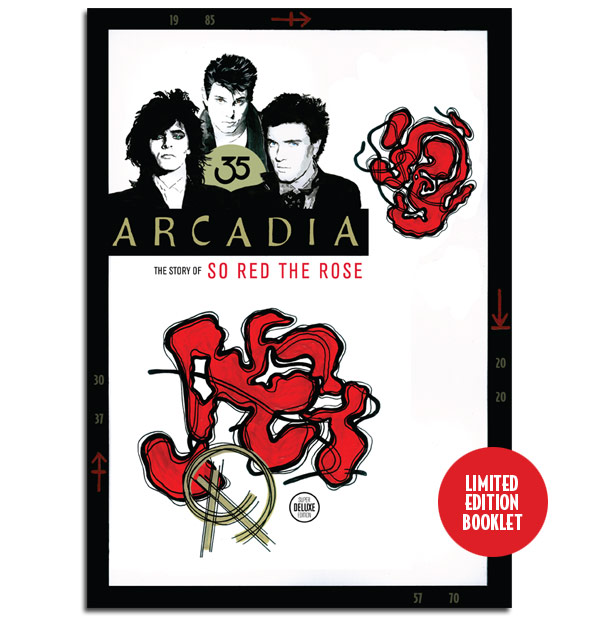
Why not celebrate this album and support SDE by pre-ordering the exclusive ‘keepsake booklet’ edition of Arcadia: The Story of So Red The Rose from the SDE shop using this link or the button below. The booklet edition is an expanded version of the feature above, with more than 2000 extra words from the interviews.
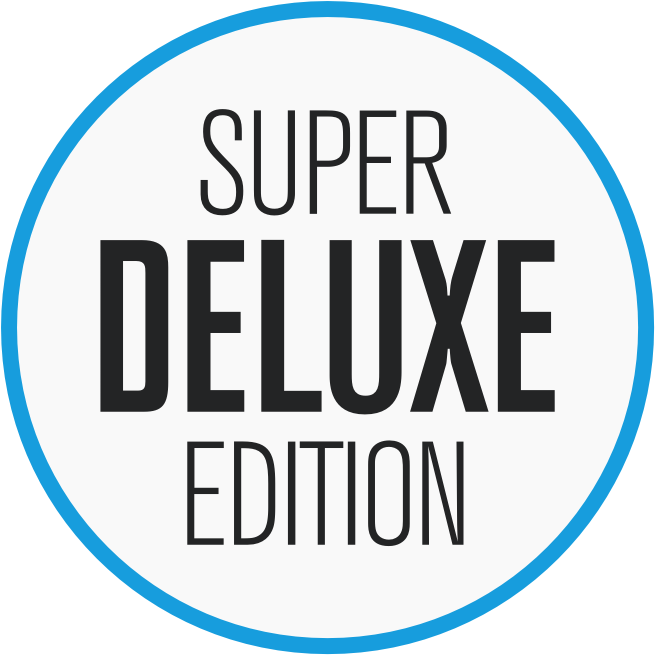
 Interview
Interview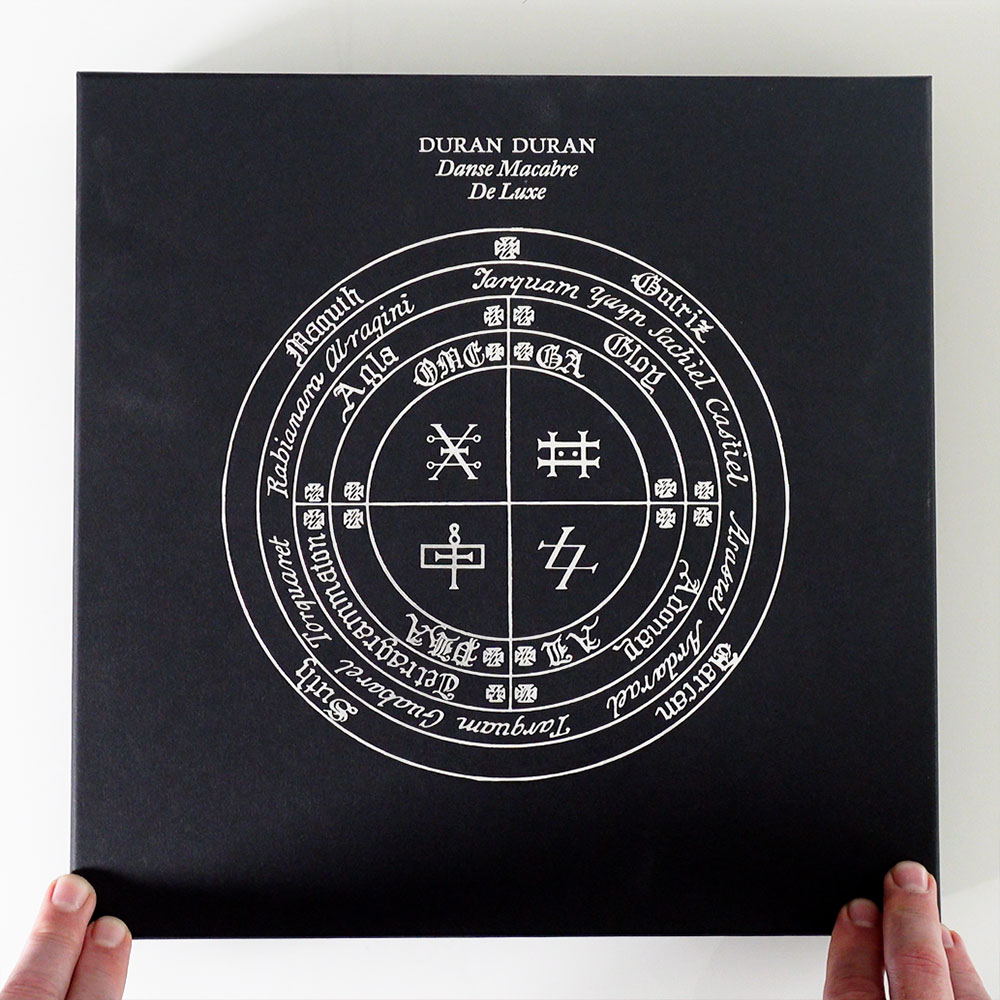
 SDEtv
SDEtv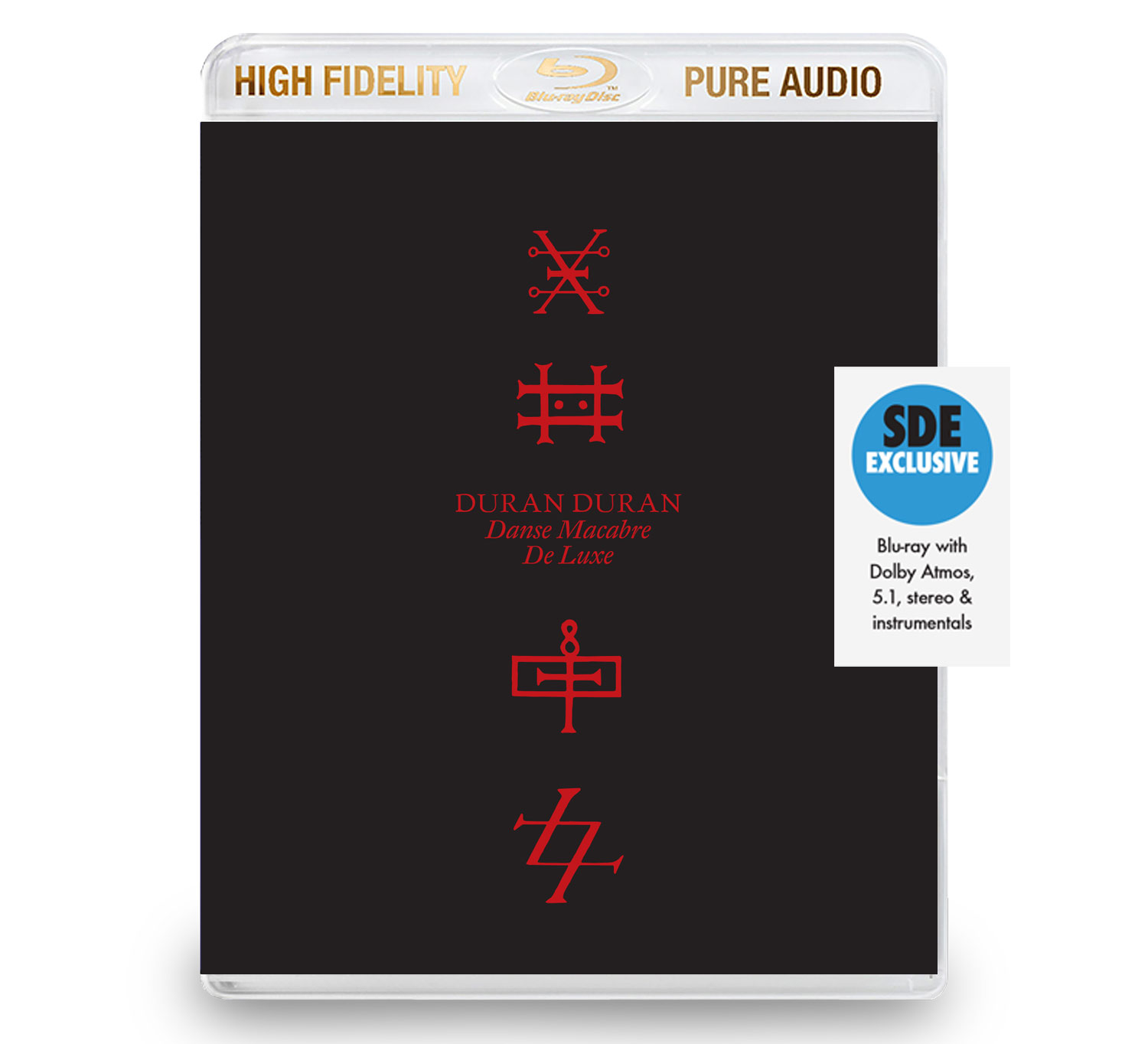
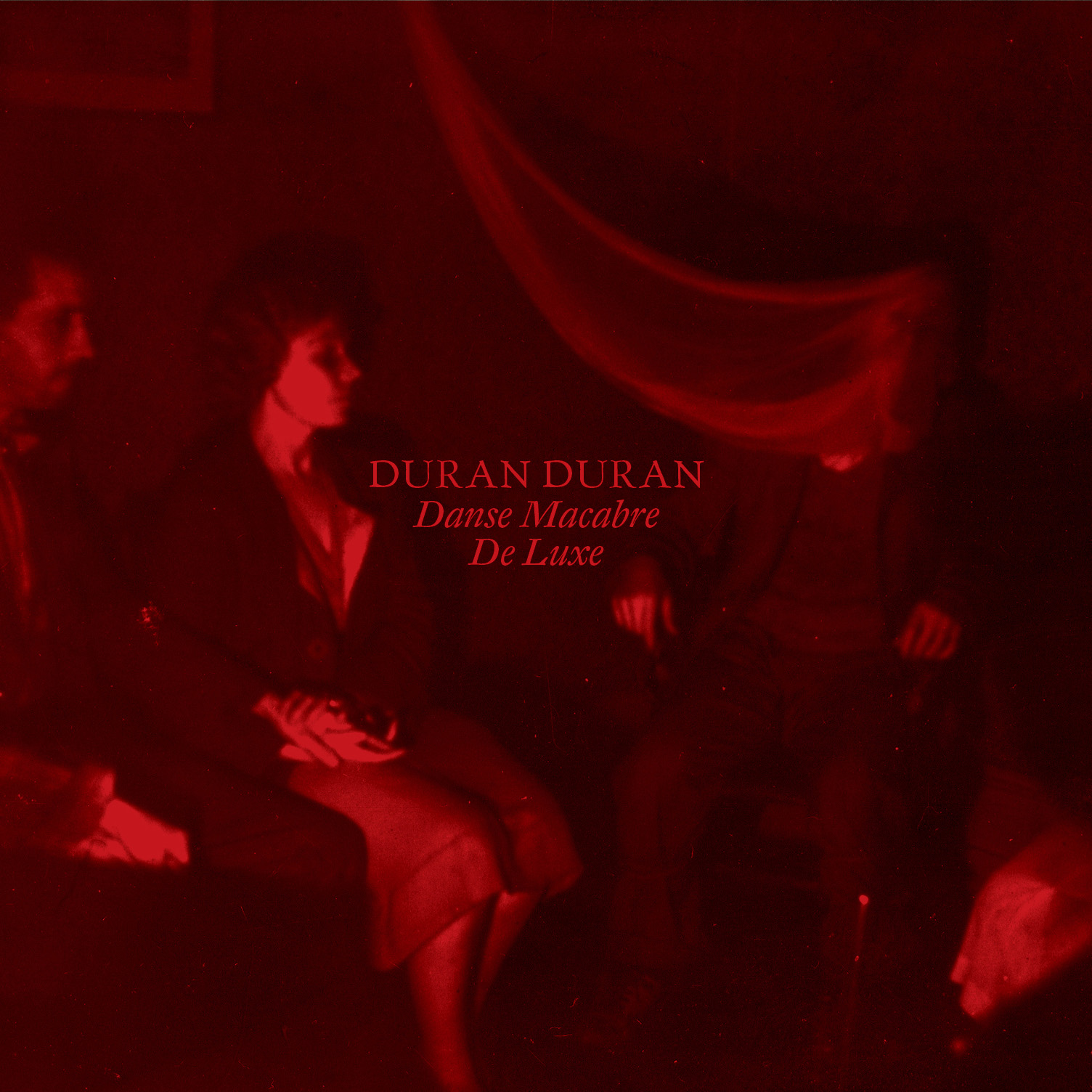
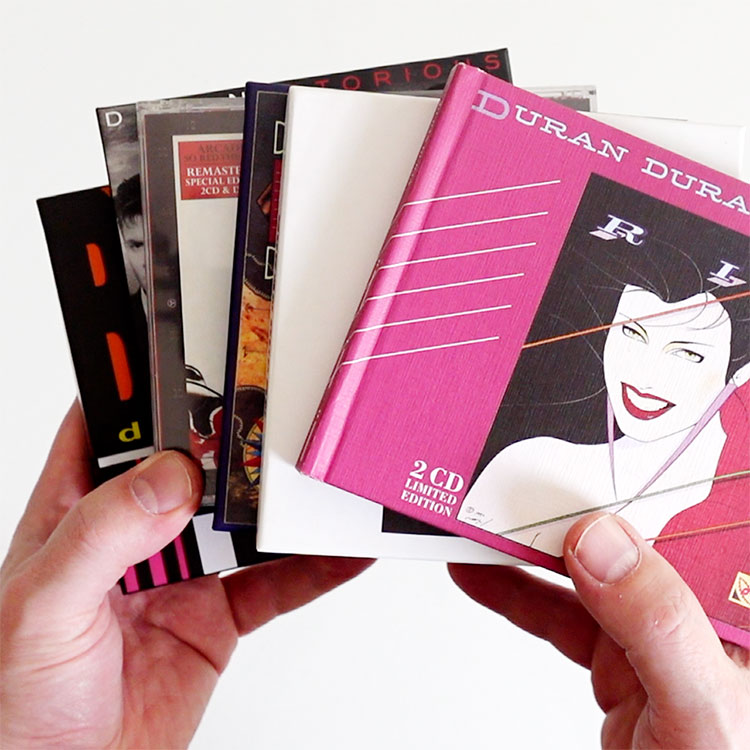
By John Earls
88